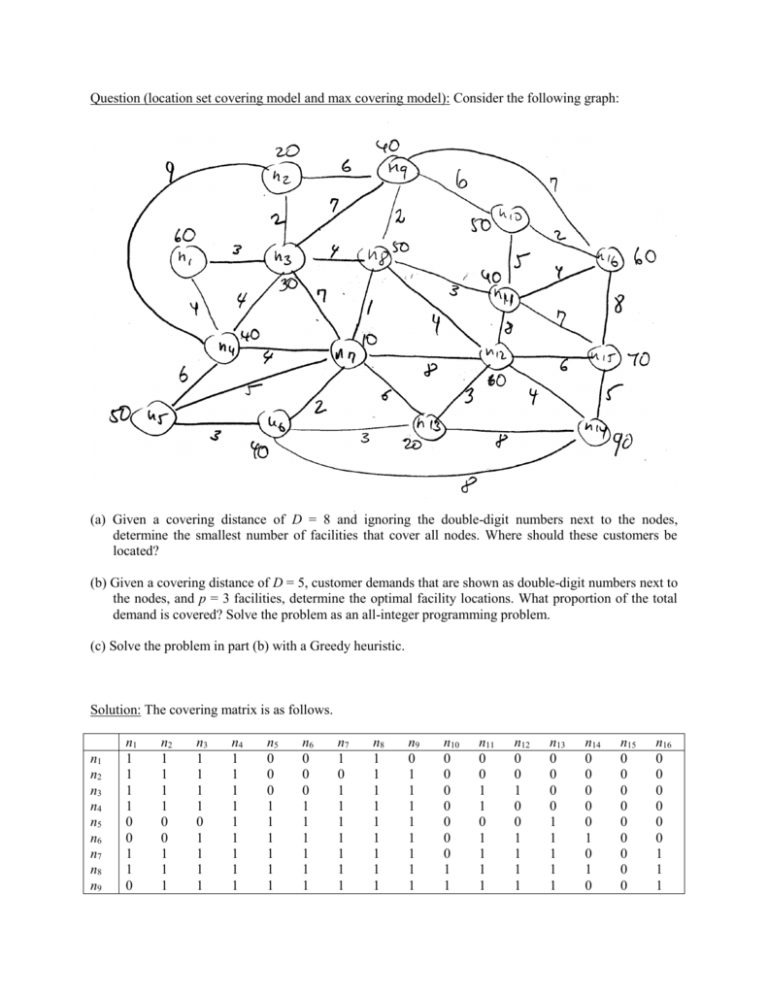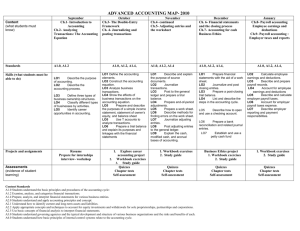6. Location set covering
advertisement

Question (location set covering model and max covering model): Consider the following graph: (a) Given a covering distance of D = 8 and ignoring the double-digit numbers next to the nodes, determine the smallest number of facilities that cover all nodes. Where should these customers be located? (b) Given a covering distance of D = 5, customer demands that are shown as double-digit numbers next to the nodes, and p = 3 facilities, determine the optimal facility locations. What proportion of the total demand is covered? Solve the problem as an all-integer programming problem. (c) Solve the problem in part (b) with a Greedy heuristic. Solution: The covering matrix is as follows. n1 n2 n3 n4 n5 n6 n7 n8 n9 n1 1 1 1 1 0 0 1 1 0 n2 1 1 1 1 0 0 1 1 1 n3 1 1 1 1 0 1 1 1 1 n4 1 1 1 1 1 1 1 1 1 n5 0 0 0 1 1 1 1 1 1 n6 0 0 0 1 1 1 1 1 1 n7 1 0 1 1 1 1 1 1 1 n8 1 1 1 1 1 1 1 1 1 n9 0 1 1 1 1 1 1 1 1 n10 0 0 0 0 0 0 0 1 1 n11 0 0 1 1 0 1 1 1 1 n12 0 0 1 0 0 1 1 1 1 n13 0 0 0 0 1 1 1 1 1 n14 0 0 0 0 0 1 0 1 0 n15 0 0 0 0 0 0 0 0 0 n16 0 0 0 0 0 0 1 1 1 n10 n11 n12 n13 n14 n15 n16 0 0 0 0 0 0 0 0 0 0 0 0 0 0 0 1 1 0 0 0 0 0 1 0 0 0 0 0 0 0 0 1 0 0 0 0 1 1 1 1 0 0 0 1 1 1 0 0 1 1 1 1 1 1 0 1 1 1 1 0 0 0 1 1 1 0 0 0 0 1 1 1 1 0 0 1 1 0 1 1 1 1 1 0 0 0 1 1 1 0 0 0 0 1 1 1 1 0 0 1 1 0 1 1 1 1 1 0 0 0 1 1 There are no essential columns. First delete dominated rows. Row 1 dominates rows 3, 4, 7, and 8, row 5 dominates rows 6 and 9, row 10 dominates rows 11 and 16, and row 14 dominates rows 12 and 13. This results in the reduced covering matrix n1 n2 n5 n10 n14 n15 n1 1 1 0 0 0 0 n2 1 1 0 0 0 0 n3 1 1 0 0 0 0 n4 1 1 1 0 0 0 n5 0 0 1 0 0 0 n6 0 0 1 0 1 0 n7 1 0 1 0 0 0 n8 1 1 1 1 1 0 n9 0 1 1 1 0 0 n10 0 0 0 1 0 0 n11 0 0 0 1 0 1 n12 0 0 0 0 1 1 n13 0 0 1 0 1 0 n14 0 0 0 0 1 1 n15 0 0 0 0 1 1 n16 0 0 0 1 0 1 Consider now column dominances. Column 8 dominates columns 1 though 7 and 9 – 15. This leaves the reduced covering matrix below, in which both remaining columns are essential. n1 n2 n5 n10 n14 n15 n8 1 1 1 1 1 0 n16 0 0 0 1 0 1 This leaves facilities located at the nodes n8 and n16, so that two facilities are needed to cover all nodes. (b) The integer programming formulation is: Min 60x1 + 20x2 + 30x3 + 40x4 + 50x5 + 40x6 + 10x7 + 50x8 + 40x9 + 50x10 + 40x11 + 60x12 + 20x13 + 90x14 + 70x15 + 60x16 s.t. y1 + y2 + y3 + y4 + y5 + y6 + y7 + y8 + y9 + y10 + y11 + y12 + y13 + y14 + y15 + y16 = 3 x1 - y1 - y2 - y3 - y4 < 0 x2 - y1 - y2 - y3 < 0 x3 - y1 - y2 - y3 - y4 - y8 < 0 x4 - y1 - y3 - y4 - y7 < 0 x5 - y5 - y6 - y7 < 0 x6 - y5 - y6 - y7 - y8 - y9 - y13 < 0 x7 - y4 - y5 - y6 - y7 - y8 - y9 - y11 - y12 - y13 < 0 x8 - y4 - y6 - y7 - y8 - y9 - y11 - y12 < 0 x9 - y6 - y7 - y8 - y9 < 0 x10 - y10 - y11 - y16 < 0 x11 - y7 - y8 - y9 - y10 - y11 < 0 x12 - y7 - y8 - y12 - y13 - y14 < 0 x13 - y6 - y7 - y12 - y13 < 0 x14 - y12 - y14 - y15 < 0 x15 - y14 - y15 < 0 x16 - y10 - y11 - y16 < 0 end int 24 The optimal solution has facilities located at nodes n3, n7, and n14, so that customers at all nodes are covered, except for nodes n10 and n16. The total number of customers covered is 620. (c) Locating the first facility, the demand covered is: [150, 110, 200, 140, 100, 210, 350, 280, 140, 150, 190, 230, 130, 220, 160, 150], so that the first facility is located at node n7. A facility at this node covers customers at n4, n5, n6, n7, n8, n9, n11, n12, and n13. In order to locate the second facility, we obtain the following marginal captures: [110, 110, 110, 90, 0, 0, x, 0, 0, 110, 50, 90, 0, 160, 160, 110], where the “x” indicates that a facility has already been located at that node. The best place to located the next facility is at node n14 or n15. We arbitrarily choose n15. A facility at node n15 covers customers at nodes n14 and n15, so that we now cover customers at the nodes n4, n5, n6, n7, n8, n9, n11, n12, n13, n14 and n15. In order to locate the third and last facility, we again compute the marginal captures. They are [110, 110, 110, 90, 0, 0, x, 0, 0, 110, 50, 0, 0, 0, x, 110]. The third and last facility is then located at either n1, n2, n3, n10, or n16. We may use secondary criteria to choose. Here, we arbitrarily pick n1. We then have covered customers at nodes n1, n2, n3, n4, n5, n6, n7, n8, n9, n11, n12, n13, n14 and n15, i.e., we have covered all nodes except n10 and n16. This means that the facilities cover a total of 620 customers, the same as in the optimal solution. Note, however, that this technique does not generally guarantee that an optimal solution is obtained.








